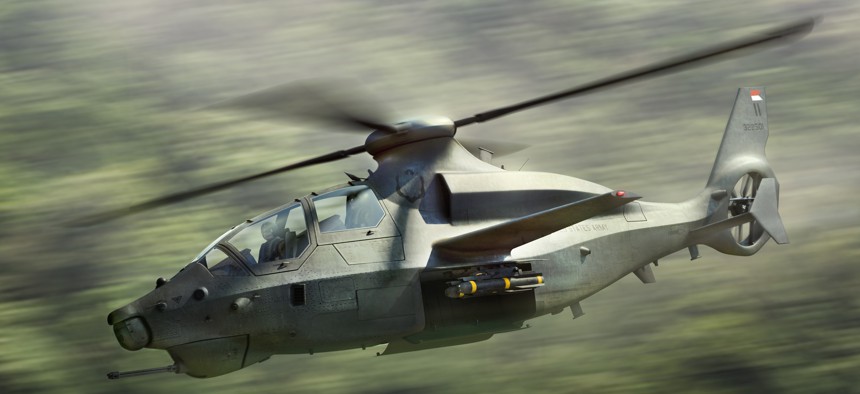
A concept image of the Bell 360 Invictus Bell
The Army’s Next Attack Helicopter Could Look Like This
Bell’s new 360 Invictus is the latest entrant hoping to fill the Army’s vertical-lift gap — and it’s remote-controlled.
After spending much of the past decade almost exclusively building and developing tiltrotor aircraft for the U.S. military, Bell is returning to its roots, pitching the U.S. Army a traditional helicopter for attack and reconnaissance missions.
The Textron company on Tuesday unveiled the Bell 360 Invictus, with a sporty-looking, new design that executives say is based on existing commercial technology, keeping it cheap to fly and maintain.
“If you need … and can afford a Corvette, do you go buy a Ferrari,” Jeffrey Schloesser, executive Bell’s vice president of strategic pursuits, said during a briefing in Arlington, Virginia. “This is not a truck. This is a high-speed, agile aircraft at an affordable price that meets all the requirements from the U.S. Army.”
Bell is one of five teams building prototypes for the Army, which wants to replace the OH-58D Kiowa Warrior helicopter it retired in 2014. The Army is calling its next-gen helicopter the Future Attack Reconnaissance Aircraft, or FARA.
As with most new weapons, Army officials want better performance: a new aircraft that is faster, can fly farther and carry more weapons than Kiowa, and that can be used to fight terrorist threats. It also is meant to fill “gaps in Army aviation attack and reconnaissance,” the Army said in April when it awarded the five teams contracts to build prototypes.
The helicopter is being built for battles in dense environments, like cities. While there are seats for two pilots, as the Kiowa had, Bell’s helicopter is being built to be flown remotely with no one in the cockpit.
Bell officials expect the new helicopter will fly by the fall of 2022, light-speed for the military and for an industry that tends to measure aircraft development programs in decades. Executives believe it's the fastest the company has designed and built a new military helicopter from scratch.
“This is extremely fast paced,” Keith Flail, Bell’s vice president of advanced vertical lift systems, said Tuesday. “Focusing on simplicity and keeping the complexity and the risk out of it as much as possible is really important.”
The company chose a standard helicopter design over a tiltrotor — like the V-22 Osprey or V-280 Valor that the company is developing for a separate Army effort — for several reasons. Most importantly, a helicopter is cheaper to build and fly.
At first glance, the Invictus bears a striking resemblance to the Comanche, a stealth helicopter the Army tried to field some 20 years ago. Compared to today’s military helicopters, the Invictus has a sportier look. One reporter in the room said the helicopter’s sleek design resembled a shark.
Similar to the Apache attack helicopter, the Invictus has a 20-millimeter gun mounted under the nose. Like stealthy fighter jets, it will carry some of its missiles and rockets internally. A computer-generated animation showed the aircraft with motorized doors opening to reveal weapons inside, which then fold out.
In an attempt to lower the cost, the Invictus uses parts from other Bell aircraft.
“We are leveraging a lot of key technologies from the 525 program.” The Bell 525 Relentless is a medium-lift helicopter that Bell is developing for commercial customers.
For example, the rotors on the Invictus are a version of the rotors used on the Bell 525.
“You can have elegance without being exotic,” Flail said. “It’s up to us to bring [the Army] the most affordable, most sustainable solution that meets their requirements — and this absolutely will.”
Bell already is conducting wind tunnel tests on a 17-percent scale model.
The helicopter’s name — 360 Invictus — is a play on special electronics that will allow the two pilots to see threats all around the aircraft.
“This has to be out there in the fight gaining and maintaining contact with the enemy — the calvary mission that the United States Army has been doing since horseback,” Flail said. “It’s the out-front scout that can’t be defeated.”
The company plans to show off a full-scale model of the aircraft at the Association of the United States Army conference and trade show in Washington, D.C., later this month.
In addition to Bell, the Army has contracted Boeing, Lockheed Martin (Sikorsky), Karem Aircraft and a team of L3Harris Technologies and AVX Aircraft to build prototypes.
L3Harris’ unveiled its design in April. Lockheed’s design will be based on its X2 technology and informed by the S-97 Raider, which is in flight-testing today.
